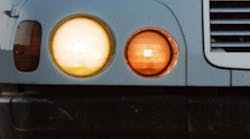There have been a lot of advances in headlamp technology for commercial vehicles. While halogen bulbs and high-intensity discharge (HID) lamps are the most commonly used on heavy duty vehicles, LED (light emitting diode) headlamps are making inroads.
Halogen headlamp systems offer competitive costing and industry standard performance. The main drawbacks of halogen is that they are not as efficient and have a relatively short life compared to some other options, such as LED lamps.
The drawbacks are accentuated in heavy duty applications where the operating environment is more severe than on cars, SUVs and light trucks.
Halogen lamps – basically a variation of an incandescent bulb – cost very little but typically have a short life, lasting only 500 to 1,900 hours, are fragile and their light output depreciates rapidly overtime. Lumen depreciation on a halogen headlamp is as much as a 25 percent reduction in light output after just 100 hours.
Lumen depreciation is when the amount of light produced decreases and light color appearance shifts over time.
A halogen lamp has halogen gas sealed into a small envelope. This inert gas allows the evaporated tungsten from the filament to reattach the material to the filament. This is called the halogen cycle.
Incandescent bulbs produce light using electricity to heat a metal filament until it becomes “white” hot or incandesces.
HID lamps – also known as xenon lamps because they contain a trace amount of xenon gas – provide much better illumination, are more energy efficient and last longer than a conventional incandescent headlamp – around 3,000 hours. HID lamps replace the filament within a glass tube of gas. Light is produced from an electric discharge that forms between two electrodes.
HID lamps emit twice the light of halogen headlamps and produce a blue-white light.
To get the better illumination, HID lamps have to be paired with a ballast which is used to regulate the high voltage supplied to the capsule of gas. These lamps require special maintenance. Potentially harmful materials are used in their construction.
LEDs
LED headlamps offer greater efficiency, less heat generation, better light color performance and much longer product life. They require very low power to work, are very durable and rugged and have lower cost over the life of the vehicle. A drawback of LEDs is that there is typically higher upfront costs.
LEDs produce light very efficiently by passing an electrical current through semiconductor material. LEDs are directional light sources, emitting light in a specific direction.
LED lamps typically do not “burn out” or fail. Rather, they experience lumen depreciation.
The lumen depreciation for LEDs is typically around a 7 percent reduction over 25,000 hours. It is really not a major factor with LEDs, but in contrast, it is a major factor with halogen headlamps
LEDs will last up to 30,000 hours and they use a very low voltage. Truck-Lite introduced the world’s first LED custom headlamps for the commercial truck market in 2012.
LED headlamps provide a much better view for the driver because the light emitted is in a color spectrum that provides high contrast and is more readily seen by the eye. This results in a much safer view of the road and a generally longer range of illumination.
There is a perception that LED headlamps are brighter because the light LEDs produce is more of a true white color. Traditional halogen headlamps that drivers are familiar with have a yellow-white hue.
Industry experts describe the color of white that halogens produce as warm white. It contains a great deal of red, a small amount of green and very little blue. This helps a driver see stop signs, but they may not see other blue or green items.
MAINTENANCE
How involved is the maintenance and repair/replacement headlamps?
Halogen bulb replacements are very readily available, with well-established service methods. LED lamp assemblies are interchangeable, but the light sources or “bulbs” are not. LED bulbs are not legal for use in the U.S.
Trucks that use proprietary headlamps versus sealed beam bulbs generally require dealer service because, in general, there are no lamps per se, but the LEDs are integral to the headlamp system.
LED headlamps are designed to last the life of the vehicle so they shouldn’t have to be replaced or repaired. There is no bulb and the solid-state nature of LEDs means that they are nearly impervious to damage from shock and vibration.
The initial install is very simple, and in nearly every case, the LED headlamps are backwards and forwards compatible. The halogen headlamp is removed and the LED lamp is installed in the same way.
Depending on the vehicle electronics, there may need to be a minor software change in some vehicles to accommodate light-out detection features on today’s trucks
Regardless of the type of headlamp, they need to be aimed properly. Headlamps pointed as little as one degree too high can make a big difference to oncoming drivers. Furthermore, misaimed beams do not cast as much light on the road.
Fleets should incorporate a regular preventive maintenance (PM) schedule to assure that vehicle headlamps are properly aimed.
All headlamps should be kept clean because even a thin layer of grime and dirt on the lens can block light output and degrade a driver’s night visibility.
NEXT?
An evolving vehicle headlamp technology for commercial trucks, as a way to improve visibility, is adaptive driving beam (ADB) headlamp systems. Basically, these are headlamps that adapt to the presence of opposing and preceding vehicles by automatically modifying portions of their beam pattern to reduce glare.
The objective is to improve long-range visibility for the driver without causing discomfort, distraction and glare to the driver or others on the road.
Europe and Japan have begun allowing ADB headlamp systems as optional equipment on select models. The National Highway Traffic Safety Administration (NHTSA) – which regulates automotive lighting, signaling and reflective devices in the U.S. – currently does not address this type of front lighting system.
However, NHTSA (www.nhtsa.gov) – an organization dedicated to achieving the highest standards of excellence in motor vehicle and highway safety – has been conducting research into adaptive driving beam headlamp systems both here and abroad.
SAE International (www.sae.org) – a global association of engineers and related technical experts in the aerospace, automotive and commercial vehicle industries – is working on a recommended practice – SAE J3069 – for test procedures, performance requirements and design guidelines for ADB systems and associated equipment.
Contributing to this article were:
- Brad Van Riper, senior vice president and chief technology officer, Truck-Lite Co. (www.truck-lite.com), a major producer of safety lighting, forward lighting, wiring harnesses, mirrors, turn signal switches and safety accessories to the heavy duty truck, trailer and commercial vehicle industries.
- Joe Weingardt, Business Development Manager, White Light Business Unit, Grote Industries (www.grote.com), a leading worldwide manufacturer and supplier of LED Lights and lighting products for heavy duty trucks, trailers, vocational and passenger vehicles.




